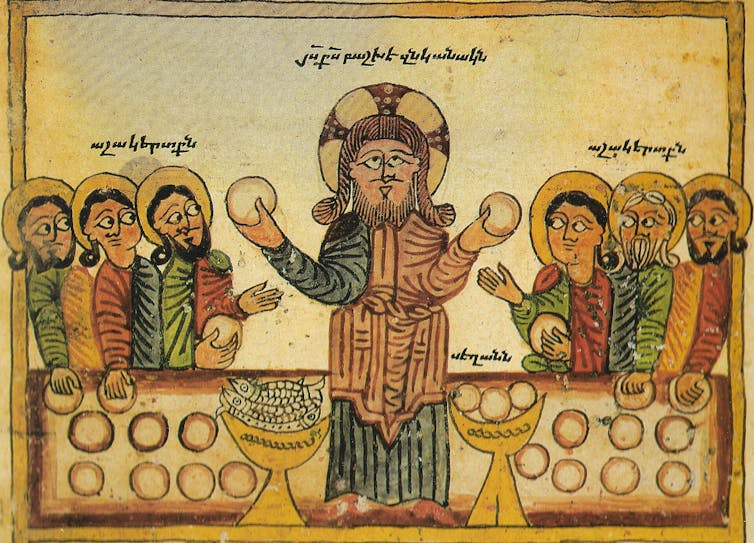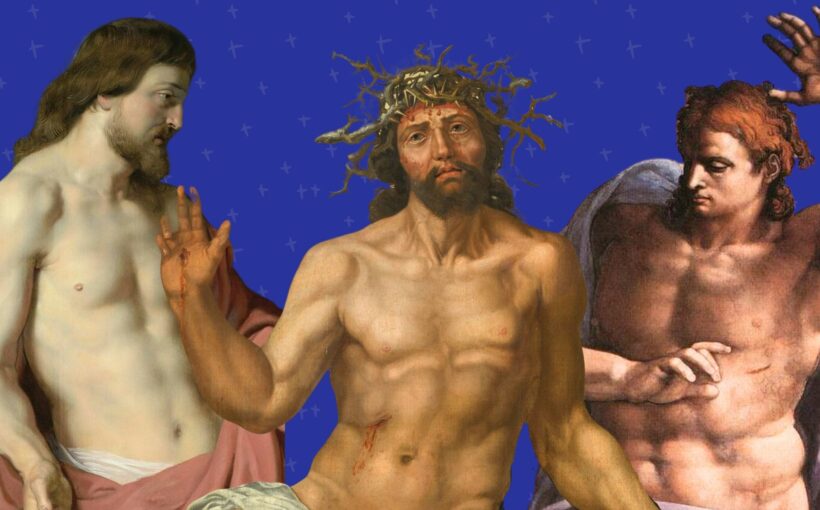
Have you ever wondered why so many images depicting the crucifixion show Jesus with a very defined, slender and toned body? Either slim, but with a six-pack, or displaying muscles and brawn. While these images are hardly a reflection of what little can be surmised about the historical Jesus, they certainly reflect social and cultural ideas about masculinity and idealised notions of manhood.
In many images of the crucifixion, Jesus is depicted as both strong and vulnerable. Crucifixion paintings showing a muscular messiah suggest that Jesus could perhaps physically have overcome his fate, had he wanted to. This interpretation of the crucifixion story amplifies the emotional and spiritual strength of his sacrifice.
The Bible is full of strong men and pumped prophets. Working the land is Adam’s punishment for eating from the Tree of Knowledge. Noah builds a massive ark, filling it with every bird, animal and food. Samson has superhuman strength in the book of Judges – his only weakness is women.
The opening of Matthew’s Gospel details Jesus’ genealogy in detail, and it is clear that he has other hardmen in his DNA. It speaks of Abraham and David, particularly. In Genesis 14, we learn how Abraham gathered an army of over 300 men and launched an attack to save his family. In Genesis 21, he also fathers a child at the age of 100 – his son, Isaac.
David is also mentioned as an ancestor of Jesus. He was famous for killing Goliath, whose immense stature has been estimated as 9ft 9in. In the Book of Samuel, David kills 200 Philistine men and brings their foreskins to King Saul, so that he will allow him to marry his daughter, Michal.
While some portrayals of Jesus have caused outrage, like those, for example, that represent him as feminine or sexualised, a similar outcry does not seem to follow the muscular Jesus.
There is a story in the gospels of Jesus’s physical strength, when he drives out those who were buying and selling in the temple, overturning tables in his anger. In the New Testament, the gospels even narrate a Parable of the Strong Man.
The endurance of physical torture before the crucifixion has been well documented in religious iconography, such as the Stations of the Cross, as well as in films such as Mel Gibson’s The Passion of the Christ (2004). Jesus also has to be mentally strong to overcome Satan, so depictions of his physical strength are perhaps supposed to echo his superhuman, spiritual strength.
‘Behold the man!’
Paintings that depict Jesus with a six-pack have influenced factions of Christianity. In the 19th century, the idea of “muscular Christianity” took hold. The term, invented in 1857, describes those Christians who see moral and religious value in sports.
In his book God’s Gym (1997), professor of religion Stephen Moore explores the quest for Jesus in a perfect human masculine form, and how this is connected to physical culture and male narcissism. Masculine Christian spirituality is often aligned with the values of courage, strength and power.
While his ministry isn’t known for its exercise focus, Jesus’s fitness can be seen in some interpretations of the gospels. He walked for 40 days in the vast wilderness and carried a heavy cross on his back.

Through the Eucharist (“take and eat, this is my body”), Jesus’s body became sacrament. This has palpable implications for many modern Christians. If Jesus’s physical fitness is a sign of his holiness, then it is something to aspire to.
Theologian Lisa Isherwood’s book The Fat Jesus (2008) explores Christian women’s weight-loss cultures through programmes such as “Slim for Him”. Feminist theologian Hannah Bacon’s book Feminist Theology and Contemporary Dieting Culture (2019), meanwhile, analyses the problematic use of “sin/syn” to refer to “bad” foods in weight-loss programmes.
For some Christians, depictions of Jesus as strong and muscular represent the ideal of a man’s body. They interpret Biblical stories in ways that mirror these paintings. Many of these groups believe that Biblical ideas of masculinity are under attack. In response, they put on events designed to attract men to church and promote the ideals of biblical manhood. Praising a muscular body ideal for men – and for Jesus – is part of that.
So next time you’re looking at a painting of Jesus in a church or gallery, do remember that such images reflect contemporary social and cultural attitudes to men’s bodies, rather than authenticity, in their artistry.

Looking for something good? Cut through the noise with a carefully curated selection of the latest releases, live events and exhibitions, straight to your inbox every fortnight, on Fridays. Sign up here.
![]()
Chris Greenough does not work for, consult, own shares in or receive funding from any company or organisation that would benefit from this article, and has disclosed no relevant affiliations beyond their academic appointment.



